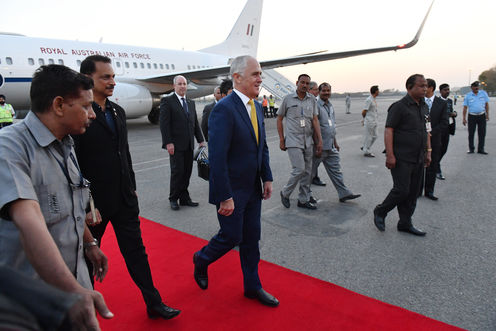Oceanía /Australia/Abril del 2017/Noticias/https://theconversation.com/
Cinco cosas que la Costa Este puede Aprender
de WA sobre Energía
Reseña:
Es un momento interesante para participar en la política energética. Mediante la crisis energética de la Costa Este, el cierre de la central eléctrica de Hazelwood y los apagones de Australia del Sur, el público pasa de una lectura de folletos ha estar familiarizado con todo tipo de conceptos esotéricos. Opinan que , WA está bien situada para investigar, desarrollar y desplegar las soluciones energéticas que todo el país y se podría utilizar en última instancia. En este sentido exponen que hay cinco razones necesarias: 1. Un demanda por el cambio. 2. Microgrids, máximo resiliencia.3. Pruebas y exámenes superan críticas e informes. 4. El trabajo calificado es abundante. 4. El trabajo calificado es abundante. En consecuencia señalan que as empresas de servicios públicos de WA ya dependen en gran medida del apoyo del gobierno estatal a la innovación tecnológica, pero también tienen fuertes redes de expertos locales capaces de cerrar los silos entre la academia, la industria y el gobierno y mantener el impulso en los mercados y redes más pequeños de WA.
Fuente :
https://theconversation.com/five-things-the-east-coast-can-learn-from-wa-about-energy-76398
Fuente:Imagen
Five things the east coast can learn from WA about energ
It’s an interesting time to be involved in energy policy. Thanks to the east coast energy crisis, the closure of Hazelwood power station and South Australia’s blackouts, the broadsheet-reading public suddenly finds itself conversant with all sorts of esoteric concepts, from gas peaking to five-minute price settlements.
Amid all the disruption, it’s perhaps not surprising that a long-term, coherent national energy policy remains as elusive as ever. Instead we see piecemeal announcements like pumped hydro and battery storage, none of which is itself a panacea. Some innovations can hinge on a single tweet which, while exciting, hardly gives the impression of joined-up policymaking.
Despite its name, the much-maligned National Electricity Market doesn’t extend to Western Australia, which means that federal energy policy discussions don’t always reach across the Nullarbor.
But we suggest looking west for inspiration. In our view, WA is well placed to research, develop and deploy the energy solutions that the whole country could ultimately use. Here are five reasons why.
1. An appetite for change
WA electricity customers have long recognised the advantages that energy innovations provide. More than 200,000 homes have solar panels (rapidly closing in on the penetration levels of Queensland and South Australia), and the appetite for residential battery storage is steadily growing.
This is due to a combination of factors. First, there’s the consistently sunny weather. Then there’s the fact that WA customers cannot yet choose their electricity retailer, meaning that households are more motivated to shop for solar panels to gain independence from government owned monopoly utilities, and can’t simply rely on the innovative price deals of the more nimble retailers found over east.
The vast distance and separation from the rest of Australia’s network means the WA grid won’t be joined to the NEM any time soon, meaning it will need to address the issues for itself, hopefully aided by a newly elected state government with the political capital to reform energy markets.
2. Micro grids, maximum resilience
To move successfully away from the traditional, centralised model of electricity generation, you need to maintain one of its cornerstone qualities: resilience. Being so far from literally everywhere else on the planet has embedded these traits into WA’s energy network, but has also reinforced the need to incorporate “microgrids” into network planning.
Microgrids are best thought of as small electricity sub-grids, able to function in concert with the main grid or in isolation if necessary. This increases the entire network’s resilience – you can’t have a state-wide blackout if you have plenty of microgrids.
WA currently has over 30 isolated microgrids, and is in prime position to be a test bed for more complex systems of network control, which will become necessary as these grids attempt to incorporate ever higher levels of distributed renewable energy from solar panels and other sources.
3. Trials and tests beat reviews and reports
The forthcoming Finkel Review of the National Electricity Market is clearly necessary and welcome. But while the media and political circus focuses on it, the utilities in WA are already out there testing the solutions.
The government-owned retailer Synergy and network operators Western Powerhave helped to investigate a range of innovations, such as strata peer-to-peer electricity trading, microgrids, utility-scale battery storage, demand-management, and standalone power systems for fringe-of-grid areas.
Meanwhile, the state-owned regional provider Horizon Power provides several valuable test case opportunities to understand how future grids and networks will need to operate in more remote areas. For example, it has successfully installed advanced metering infrastructure (‘smart meters’) for every one of its 47,000 customers, spread over 2.3 million square kilometres, no less.
4. Skilled labour is plentiful
During WA’s decade-long mining boom, technical skills were in high demand and short supply. It’s fair to say the opposite is now the case. Meanwhile, the state government has committed to removing 380 megawatts of fossil-fuel generation capacity from the WA energy market, most of which is situated around Collie, south of Perth.
If this pledge leads to greater opportunities for new renewable energy infrastructure it would provide welcome relief for a job market awash with underemployed technical experts, still reeling from the mining downturn.
WA’s world-leading reserves of lithium ore also offer a significance chance to join in the burgeoning battery storage industry.
With the recent closure of Hazelwood’s ancient coal-fired power station, Victoria’s Latrobe valley will no doubt be investigating similar opportunities, and the coal regions of Queensland and New South Wales should not be too far behind.
5. Strong links between government and experts
For WA, the disruptive transition in the energy sector is more acute, partly because its market is dominated by government-owned monopoly utilities that rely heavily on subsidies to ensure consistent power prices. But mostly because in WA there is a very direct link between power prices and politics, and electricity is always a hot topic at state elections.
Because of its physical isolation, WA’s energy policies are also largely independent from the rest of the COAG Energy Council.
As described in point 3 above, utilities will need to be prepared to spend significantly on research and development if they want to survive. WA’s utilities already rely heavily on state government support for technology innovation, but also have strong networks of local experts that are able to bridge the silos across academia, industry and government and keep the momentum going in WA’s smaller markets and grids.
So that was five reasons, among many more, why we think WA has a chance for not just Australian, but global leadership in the renewable power transition. As the rest of the country grapples with its energy headaches, it should consider looking west once in a while.

















 Users Today : 18
Users Today : 18 Total Users : 35460321
Total Users : 35460321 Views Today : 22
Views Today : 22 Total views : 3419050
Total views : 3419050